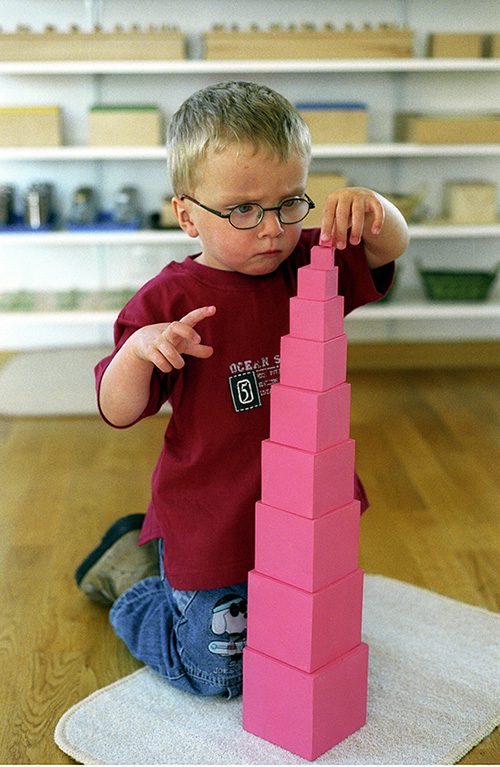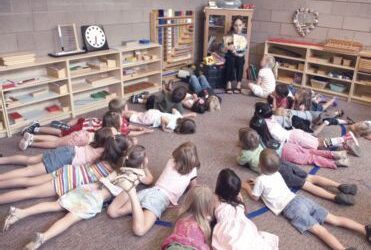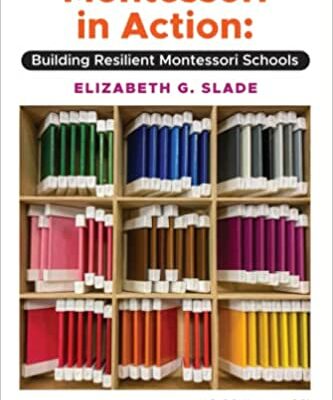
The Montessori Classroom
Montessori classrooms are bright, warm, and inviting. They are filled with plants, animals, art, music, books, and interest centers filled with intriguing learning materials, fascinating mathematical models, maps, charts, fossils, historical artifacts, computers, scientific apparatus, perhaps a small natural science museum, and animals that the children are raising.
You will not find rows of desks in our classrooms. Montessori learning environments are set up to facilitate student discussion and stimulate collaborative learning. One glance and it is clear that our children feel comfortable and at home.
Students will typically be found scattered around the classroom, working alone or with one or two others. They will tend to become so involved in their work that we cannot help but be tremendously impressed by the peaceful atmosphere.
It may take a moment to spot the teachers within the classrooms. They will be found working with one or two children at a time, advising, presenting a new lesson, or quietly observing the class at work.
In her research, Dr. Montessori noted specific characteristics associated with the child’s interests and abilities at each plane of development. She argued that a school carefully designed to meet the needs and interests of the child will work more effectively because it is consistent with basic principles of psychology. Rather than fight the laws of nature, Montessori suggested that we “follow the child” and allow our children to show us how to facilitate the development of their human potential.
This focus on the “whole child” led Montessori to develop a very different sort of school from the traditional adult-centered classroom. To emphasize this difference, she named her first school the “Casa dei Bambini” or the “Children’s House.”
There is something profound in her choice of words, for the Montessori classroom is not the domain of the adults in charge, but rather a carefully prepared environment designed to facilitate the development of the children’s independence and sense of personal empowerment.
This is a true community of young children. They move freely within the rooms, selecting work that captures their interest, rather than passively participating in lessons and projects selected by the teachers.
In a very real sense, even the very youngest students in Montessori take care of their own child-sized environment. When they are hungry, they prepare their own snack and drink. They go to the bathroom without assistance. When something spills, they help each other carefully clean things up. Parents are often amazed to see small children in Montessori classrooms cut raw fruits and vegetables, sweep and dust, carry pitchers of water, and pour liquids with barely a drop spilled. These little ones normally go about their work so calmly and purposely that it is clear to even the casual observer that this is their environment: The Children’s House.
The Montessori classroom is commonly referred to as a prepared environment. This name reflects the care and attention that is given to creating a learning environment that will reinforce the children’s independence and intellectual development.
Respect, Intelligence, and Independence
We know that young children are full and complete individuals in their own right. They deserve to be treated with the full and sincere respect that we would extend to their parents. Respect breeds respect and creates an atmosphere within which learning is tremendously facilitated.
Montessori schools believe very strongly that intelligence is not fixed at birth, nor is the human potential anywhere near as limited as it sometimes seems in traditional education.
Success in school is directly tied to the degree to which children believe that they are capable and independent human beings. If they knew the words, even very young children would ask: “Help me learn to do it for myself!”
By allowing children to develop a meaningful degree of independence and self-discipline, Montessori sets a pattern for a lifetime of good work habits and a sense of responsibility. Students are taught to take pride in doing things for themselves carefully and well.
Montessori Teaches Children to Think, Collaborate, and Discover
Our program is designed to help each of our students discover and develop his or her unique talents and possibilities. We treat each as a unique individual learner. We know that no two students will learn at the same pace, nor will they necessarily learn best from the same teaching methods, and our goal is to be flexible and creative in addressing each student as a unique individual.
In Montessori, students and teachers learn to collaborate in the process of education rather than mindlessly compete. Our students discover their own innate abilities and develop a strong sense of independence, self-confidence, and self-discipline. In an atmosphere in which children learn at their own pace and compete only against themselves, they learn not to be afraid of making mistakes. They quickly find that few things in life come easily, and they can try again without fear of embarrassment.
One way of thinking about the difference between our approach and one that is more traditional is to consider that while learning the right answers may get our children through school, learning how to become a life-long independent learner will take them anywhere! Our children are learning to think, observe, and reflect; not memorize and quickly forget.
Rather than present students with loads of right answers, their teachers ask the right questions and lead the children to discover the answers for themselves. Learning will become its own reward, and each success will fuel their desire to discover even more.
The Elementary students are encouraged to do their own research, analyze what they have found, and come to their own conclusions. The teachers encourage our children to think for themselves and become actively engaged in the learning process.
Freedom of Movement and Independently Chosen Work
Montessori children are free to move about, working alone or with others at will. They may select any activity and work with it as long as they wish, so long as they do not disturb anyone or damage anything, and so long as they put it back where it belongs when they are finished.
The Integrated Montessori Curriculum
Montessori classrooms are organized into several curriculum areas, which include language arts (reading, literature, grammar, creative writing, spelling, and handwriting), mathematics and geometry, everyday living skills, sensory awareness exercises and puzzles, geography, history, science, art, music, and movement. Most rooms will include a classroom library. Each area is made up of one or more shelf units, cabinets, and display tables with a wide variety of materials on open display ready for use as the children select them.
Montessori curriculum is organized into a spiral of integrated studies, rather than a traditional model in which the curriculum is compartmentalized into separate subjects, with given topics considered only once at a specific grade level. In the early years, lessons are introduced simply and concretely and are reintroduced several times over succeeding years at increasing degrees of abstraction and complexity.
The course of study uses an integrated thematic approach that ties the separate disciplines of the curriculum together into studies of the physical universe, the world of nature, and the human experience.
Literature, the arts, history, social issues, political science, economics, science, and the study of technology all complement one another. This integrated approach is one of Montessori’s great strengths. As an example, when our students study Africa in world history, they will also read African folk tales in world literature, create African masks and make African block print t-shirts in art, learn Swahili songs in music, and make hieroglyphic calendars in math, as well as study African animals in zoology.
Our mathematics curriculum follows a European model of unified mathematics through which students are introduced to concepts in algebra, geometry, mathematical logic, and statistics from the early years of their education, rather than waiting until high school as is normal in the United States.
The same is true in our science curriculum, weaving principles of physics, chemistry, the earth sciences, botany, and zoology together from the preschool years and up, with far greater emphasis on the sciences in general than is common in most American elementary curriculums.
Typical Class Size
A typical Montessori class is made up of from twenty-five to thirty children, representing a three-year age span, taught by two certified Montessori teachers.
Parents often wonder if it would not be better to organize classes into smaller groups, but there is actually a great deal of research, thought, and successful experience behind this particular model. The key is to remember that in Montessori, the teacher is neither the center of attention nor the sole source of instruction. The children are learning on their own by independent discovery and from each other, as well as through lessons presented by the teacher. This approach allows the children to explore and learn independently as much as possible. The stimulation of older children and the encouragement of their peers fuels the process, and all so often the best teacher of a four-year-old is an older child rather than an adult. Children learn best from one another. We create classes of thirty to ensure that each child will have enough classmates of the same sex and age group, as well as the stimulation of the older children.
Montessori Classes Encompasses a Three-Year Age Span.
Montessori classes are organized to encompass a two- or three-year age span, which allows younger students to experience the daily stimulation of older role models, who in turn blossom in the responsibilities of leadership. Students not only learn “with” each other, but “from” each other. We find that most often the best tutor is a fellow student who is just a bit older.
Some parents worry that having younger children in the same class as older ones will leave one group or the other short changed. They fear that the younger children will absorb the teachers’ time and attention, or that the importance of covering the Kindergarten curriculum for the five-year-olds will prevent teachers from giving the three- and four-year-olds the emotional support and stimulation that they need. Both concerns are misguided.
Working in one class for two or three years allows students to develop a strong sense of community with their classmates and teachers. The age range also allows especially gifted children the stimulation of intellectual peers, without requiring that they skip a grade and feel emotionally out of place.
Each class is an essentially stable community, with only the oldest third moving on to the next level each year. At each level within a Montessori school, the curriculum and methods are logical and consistent extensions of what has come before.
How Can Montessori Teachers Meet the Needs of So Many Different Children?
Montessori teachers play a very different role from those played by traditionally trained educators. While the stern disciplinarians of the past may be an endangered species, many teachers are focused on maintaining order and on covering a pre-defined curriculum. Most see their role as dispensing facts and skills to complacent students.
The Montessori teacher’s role is that of a facilitator and guide. He or she is usually not the center of attention and will not normally spend much time working with the whole class at once. Her role centers around the preparation and organization of appropriate learning materials to meet the needs and interests of each child in the class.
The Montessori teacher has four primary goals: to awaken our children’s spirit and imagination, to encourage their normal desire for independence and high sense of self-esteem, to help them develop the kindness and self-discipline that will allow them to become full members of society, and to help them learn how to observe, question, and explore ideas independently. The Montessori teacher is a coach, mentor, and friend.
The teachers rarely present a lesson to more than one or two children at a time and limit them to a quick, efficient presentation. The objective is to intrigue the children so that they will come back on their own to work with the materials. Lessons center around clear and simple information that is necessary for the children to be able to do the work on their own: the name of the material, its place on the shelf, the ground rules for its use, and some of the possibilities inherent within it.
The teachers closely monitor their students’ progress, keeping the level of challenge high. Because they come to know the children so well, Montessori teachers can often use their own interests to enrich the curriculum and provide alternate avenues for accomplishment and success.
The Montessori Materials – A Road from the Concrete to the Abstract
The basis of our approach is the simple observation that children learn most effectively through direct experience and the process of investigation and discovery. In her studies of children’s learning, Dr. Montessori noted that most children do not learn by memorizing what they hear from their teachers or read in a text, but rather from concrete experience and direct interaction with the environment. Asking a child to sit back and watch us perform a process or experiment is like asking a one-year-old not to put everything in his mouth. Children need to manipulate and explore everything that catches their interest.
This led Montessori to emphasize the overriding importance of concrete learning apparatus and to the development of the Montessori materials for mathematics, sensory development, language, science, history, and geography.
The Montessori learning materials are not the method itself, but rather tools that we use to stimulate the child into logical thought and discovery. They are provocative and simple, each carefully designed to appeal to children at a given level of development.
Each material isolates and teaches one thing or is used to present one skill at a time as the child is ready. Montessori carefully analyzed the skills and concepts involved in each subject and noted the sequence in which children most easily master them.
To facilitate the prepared order of the environment, the teacher arranges the materials on the shelf following their sequence in the curriculum flowchart. The materials are displayed on low open shelves that are easily accessible to even the youngest children. They are arranged to provide maximum eye
appeal without clutter. Each has a specific place on the shelves, arranged from the upper-left-hand corner in sequence to the lower right. Materials are always arranged in sequence, from the most simple to the most complex, and from the most concrete to those that are the most abstract.
Preparing Tomorrow’s Innovative Thinkers Today
In a world of rapid change and new discoveries, we can only guess at the skills our children will need to succeed in the 21st century. Now, more than ever, the essential lesson is learning how to learn.
The most important years in our children’s education are not high school and college, but, instead, their first twelve years of life. This is when their character and values, self-image, basic skills and knowledge, and appreciation for culture and the arts are formed.
Montessori offers our children a world-class education, along with an education of the heart, that nurtures their self-confidence, personal creativity, and entrepreneurial spirit.
It offers them the most challenging academic program that they can handle in a course of study that includes the Junior Great Books, creative writing, unified mathematics, geometry, pre-algebra, history, geography, economics, philosophy and ethics, computers, botany and zoology, the physical sciences, foreign language study, art, music, dance, and physical education.
We can see our children as they truly come to love learning and begin to discover their true potential as young men and women.
Montessori’s goal is to nurture their intelligence and creativity, helping our child become renaissance individuals in the intellectual tradition of Thomas Jefferson, Buckminster Fuller, and Maria Montessori.
Granted, this lies beyond the scope of traditional education, but then Montessori schools are different.
As families, we come to Montessori schools to give our children an outstanding preparation for high school, college, and life.






